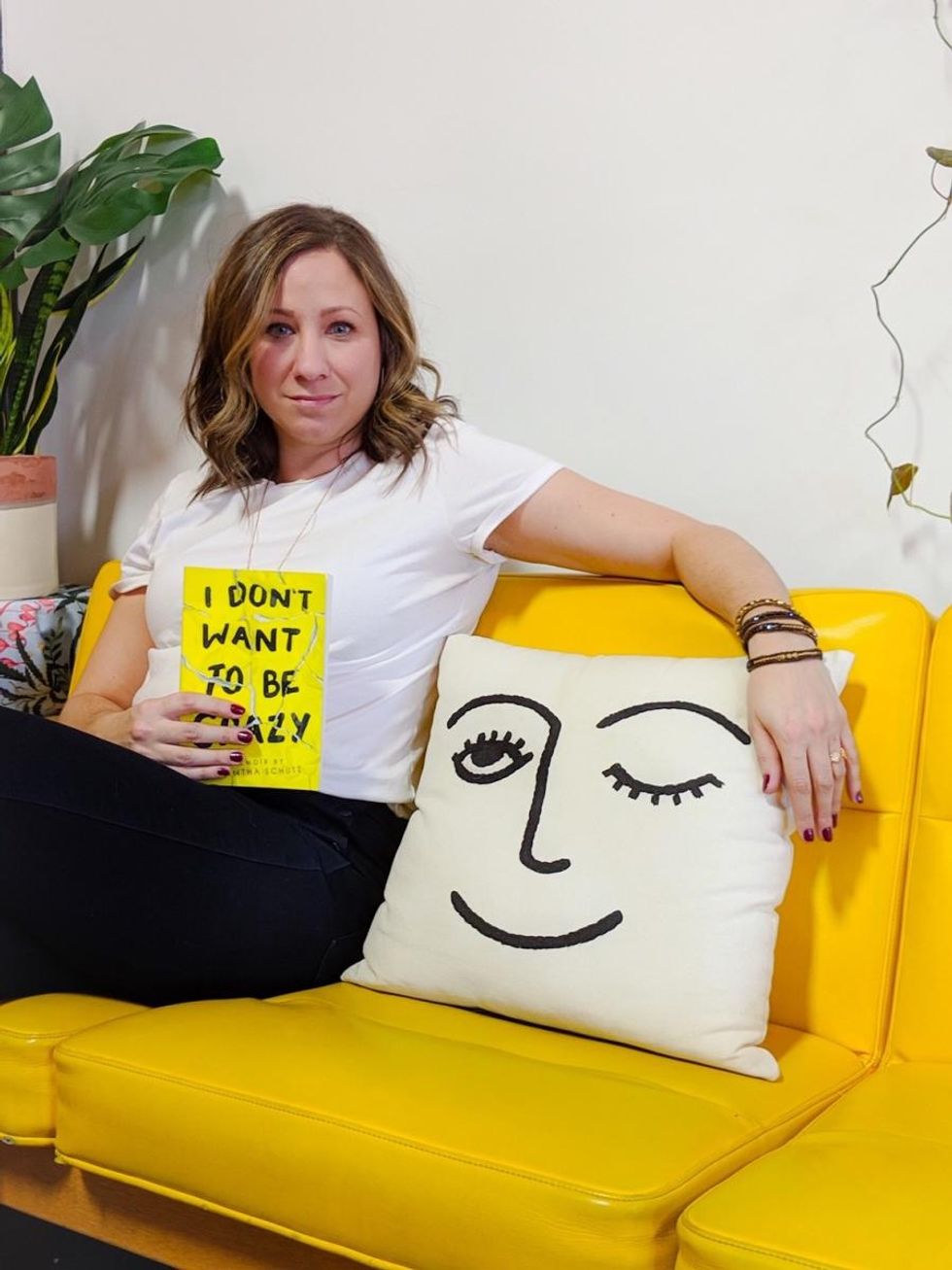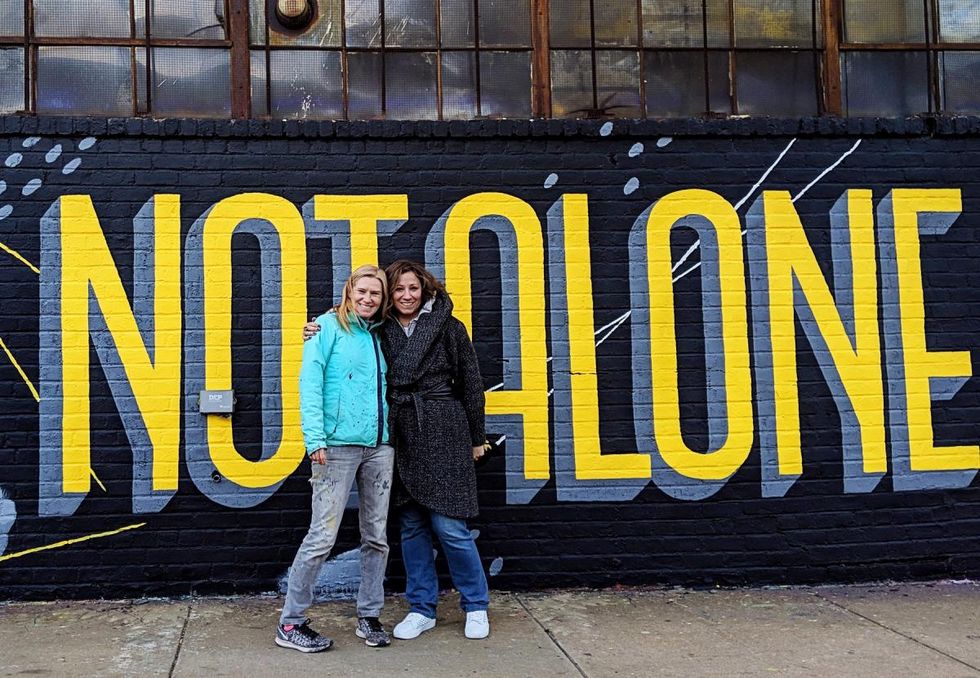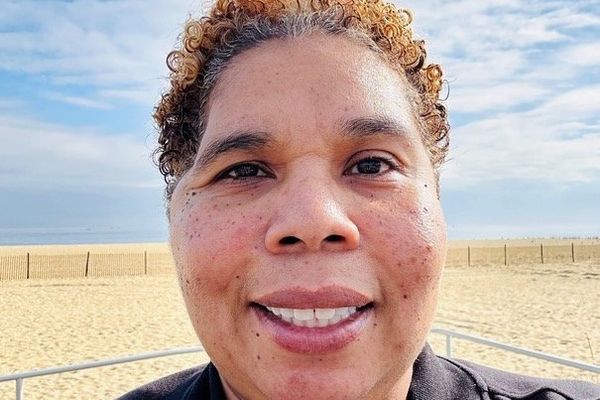By Sam Schutz
I can’t sit still in class.
I can’t hear what the teacher is saying.
All I can hear is my voice in my head
telling me that things are not right—
that I am not right.
I am trapped in this classroom.
It feels like something
is trying to push its way out of me,
out of my chest.
I feel like everyone can see it bubbling up,
like they’re waiting for me to burst,
to boil over.
I have to get out of here.
I fake a coughing fit and leave,
but once I get in the hallway
I realize I’m still trapped—
stuck inside of this shaking, sweating body.
I’d rip my skin off if I could.
The only place that seems safe
is the bathroom.
Sitting in a stall, with my chest on my thighs,
I try to breathe,
But the more I think about my breathing,
the more I feel like I can’t breathe.
It feels like I have a raging fever,
like my insides are melting.
This must be what it feels like
the moment before you die.
Excerpt from I Don’t Want to Be Crazy, by Samantha Schutz
Shortly after starting college, I began having frequent, unexpected, and terrifying bursts of anxiety. These attacks made me feel as if I were going to faint, go insane, or die. The attacks were so disruptive to my everyday life that I sought the help of a therapist and psychiatrist. I was subsequently diagnosed with panic disorder, a kind of anxiety disorder. Panic attacks are sudden feelings of terror when there is no real danger. The intensity of an attack peaks after several minutes, and it is accompanied by physical symptoms like heart racing, sweating, and trembling. I was prescribed medication to help control the attacks as well as provide me with a bit of calm to start working through the parts of my life that were contributing to my body’s extreme fight or flight reaction. In the years since, there were long stretches where I had no attacks and other periods when the panic was all I could think about. I’ve seen several different therapists over the years and also taken breaks in-between when I felt I didn’t need the support. I have also consistently been on medication since college.
After college, I published a memoir about struggling with anxiety. I have also written articles and given talks about my experiences with therapy, psychiatrists, medication, and self-care. Each time I’ve focused only on my point of view. After all, I was the one suffering. My perspective was the one that mattered most, right?
However, dealing with a mental health issue rarely affects only the person who has been diagnosed. Mental health challenges sendshock waves great and small into the lives of partners, family, friends, and co-workers. So for the first time I wanted to offer a new point of view and pair my experience during a panic attack with how it simultaneously looks and feels to my best friend of more than twenty years.
Here is a peek into how we both feel.
What goes through your head when you make/receive a call for support during a panic attack?
Samantha: If a panic attack has gotten to the point where I need support, that means I’ve already tried to calm myself down and it hasn’t worked. If the attack is bad enough that I’ve called someone for help, then I’ve certainly already taken medication prescribed by my doctor to help soothe me. I’m very fortunate to have a handful of people I can call in a situation like this, but it’s far from easy to pick up the phone. A lot of things are racing through my head. Can I handle this alone? Who can I call? What if they don’t pick up? Am I bothering them? Am I a burden? There is also a part of me that feels broken and embarrassed that I need help. I try to remind myself that I know I will feel better if I tell someone what I am going through and that it will release some of the pain.
Annica: My first thought is that I am glad she’s telling me what’s happening. Nothing crushes me more than hearing about it after the fact and not having been able to be present for her. I have never once paused at the thought of dropping whatever I’m doing to show up. In the way back of my mind I worry: what if I can’t provide her with the help she needs? What if she feels she needs to go to the hospital? What will that look like? But that has never happened and I know if it ever did come to that, we’d figure it out together.
What are you feeling and noticing when you’re finally together?
Samantha: I feel like a ticking time bomb while I’m waiting for her to get there. Time moves so slowly. So I feel a lot of relief when she arrives—like I can finally let out a big exhale. There’s still a part of me that feels embarrassed and I think: why can’t I handle this on my own? My face will certainly be red and puffy and my nose will be stuffed up from all the crying. I don’t know that I’m great at articulating what’s actually happening since my mind isn’t in a rational place. My thoughts are racing. I feel scared and like something is really wrong with me. I often struggle with making the choice to take a second dose of medication and having someone there to tell me it’s ok to take can be really helpful.
Annica: I see that she is both present and not present. She’s in the room and talking to me, but part of her is somewhere else. I can see her pain very clearly and I can see that it will end—something I know she can’t yet see.
What kind of support do you need/provide?
Samantha: Just having someone there—or on the phone—makes such an immediate difference. I need someone to be rational since that part of my brain has been totally overpowered. Hearing someone tell me that I will be ok and that they will do whatever they can to help me is an immense comfort. The distraction of having someone there so I am not alone with my thoughts is the thing I need most. So sitting together and not talking is ok. Hearing a story from her day is good, too. Watching TV—something incredibly familiar like Sex and the City or Golden Girls—seems to be the best thing to ease me into a better state.
Annica: When I show up I feel relieved to be able to provide her with company, but I’m also wishing there was something more active I could do to help relieve her suffering. I know that distraction is best. She doesn’t need me to entertain her beyond sitting next to her and petting her head while we watch TV. I feel like quiet is key, because I know she has a lot of noise in her head. I try to show up in a listening capacity in case she wants to talk. I want her to feel like there is space for her to voice what’s going on, but only if she wants to.
Annica’s tips for supporting a friend:
- Look out for when someone is being less responsive to texts or phone calls or not wanting to connect. Don’t get offended or assume you’ve done something, come from a place of concern.
- Be persistent but gentle. Keep reminding them you are available and willing to support them, if they’d like. Or just text them silly strings of emojis or GIFs as a reminder that you’re thinking of them.
- Be clear on the role your friend needs you to play: Do they need distraction, comfort, reassurance, or tough love? Ask them what feels best.
Sam’s tips for asking for help:
- You are not alone. You may feel like no one in the world could possibly understand what you are going through, but that’s just not true. Proof is a Google search away.
- Be vulnerable. If you don’t open up to loved ones about what you are going through, you are not giving yourself the chance to be supported. The act of opening up allows a pressure valve to be released and with that can come some relief. Vulnerability is also a two-way street. By showing your own vulnerability, that may allow the people in your life to feel more comfortable opening up to you.
- Help is out there. Going to therapy and sharing what you’re struggling with can be really uncomfortable. But the hard work is worth it to feel relief and learn tools to help manage your emotions.
- Medication can ease the pain. Some people reject the idea of taking medication that’s been suggested of prescribed by a doctor for a mental health issue because they think they should be able to deal with it on their own. But consider if a doctor prescribed a medication for a patient with pneumonia. Does that person have anything to feel guilty or ashamed about? It can take a good bit of trial and error to get medication right, but feeling better is the goal, and I believe it’s worth the effort.
Samantha and Annica co-founded the You Are Not Alone Murals Project, which launched in three locations across New York City for 2019’s Mental Health awareness month. Though inspired by a compassion for those struggling with mental health issues, the murals have broad appeal and offer support to anyone who feels misunderstood, victimized, or abandoned.
Samantha Schutz is Publishing Director, mental health advocate, and the author of the acclaimed anxiety disorder memoir, I Don’t Want to Be Crazy. She curates You Make Me Feel Less Alone, a creative community of mental health support that features submissions of original art and writing. She lives in Brooklyn, NY.
Annica Lydenberg is an art director, lettering artist and mural painter. She creates under the name Dirty Bandits and works with brands to create authentic products, campaigns and spaces with a focus on companies work for social good. She is currently living in Brooklyn with her boyfriend and her dog Barnaby and expecting her first baby.









